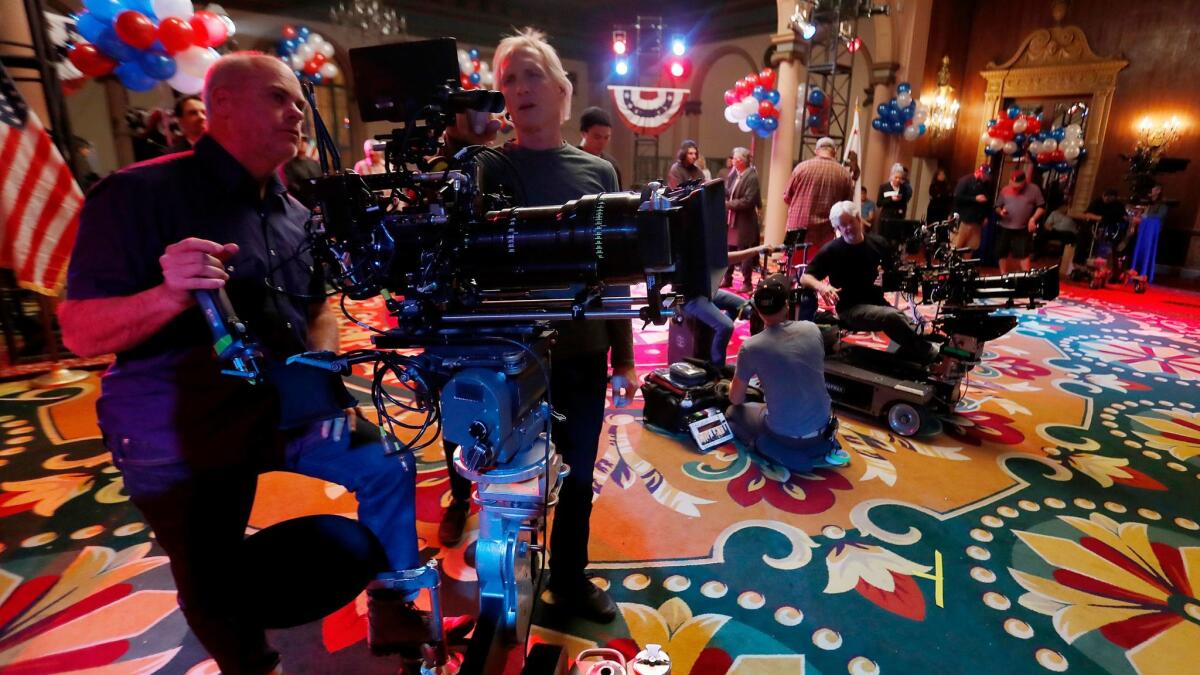Peak TV brings production jobs back to Los Angeles, with a boost from streaming series

It was already late in the day and nearly 250 extras were still waiting patiently on set as the crew for the Amazon Studios series “Goliath” put the finishing touches on a scene with actor Billy Bob Thornton being shot at the Millennium Biltmore Hotel in downtown Los Angeles.
The climactic scene from the show’s upcoming second season — which is scheduled to launch this summer — featured an enthusiastic political rally to crown L.A.’s new mayor. Production assistants arranged the extras into a tight formation and then adjusted campaign signs and balloons before three camera crews captured several takes of Thornton pushing his way through the frenetic crowd to confront the mayor-elect in a dramatic showdown.
The hours of preparation involving more than 100 crew members will result in just a few minutes of screen time. In the production industry, long, tedious days are a given. But local crews aren’t complaining as the phenomenon known as “peak TV” continues to bring back jobs to an industry that only a few years ago was reeling from the flight of production to other states and countries.
The surge in content from streaming services such as Amazon, Netflix and Hulu, as well as the major networks and premium cable channels, has had a trickle-down effect through the L.A. production industry. Expanded state film tax credits also are giving producers more incentives to shoot closer to Hollywood, industry experts say.
“I started in 1977, and I’ve never seen it as busy as it is today,” said Steve Dayan, who heads the Hollywood Teamsters Local 399, which represents about 4,500 studio drivers, location managers, casting directors and other crafts. He said employment levels for the union’s members are near peak levels. “We have been at near or full capacity in 2017, and we’re expecting 2018 to be the same.”
It’s a marked economic reversal from just a few years ago when Hollywood was contending with “runaway productions” fleeing to states such as Georgia, Louisiana and Maryland, where it is often cheaper to shoot.
“Five years ago, I was out of work,” recalled Keegan Zall, who runs craft services for TV and film productions. “A lot of people were out of work. You’re in Hollywood, and nothing was being made.”
But in the last few years, he has found steady work on shows such as NBC’s “This Is Us,” CBS’s “Scorpion” and Amazon’s “Goliath.” “Now it’s way better,” he said during a break in the “Goliath” shoot.
Shows typically employ hundreds of individuals directly and many more indirectly through vendors who provide everything from the visual effects that enhance a shot to the prop houses that supply the physical furniture and decorations for sets.
Local businesses say that the economic ripple effect is being driven mainly by streaming shows.
“Businesses like mine aren’t solely dependent on the work by the traditional studios,” said Fred Arens, president and chief executive of Objects, a Sun Valley company that provides fine furniture, accessories and textiles for film, television and commercial productions. “The trend has accelerated not only the quantity but also the quality of programming and has given my business a lifeline.”
The surge in TV production has had a measurable impact throughout the L.A. area. The average occupancy rate for certified soundstages was 96% in 2016, according to a recent study by FilmLA, the nonprofit group that oversees film permits in the city and county. Nearly 90% of soundstage shoots for that year were TV-related — including half-hour and hour-long series as well as talk shows.
On-location filming — which represents filming outside certified soundstages — rose 6.2% between 2015 and 2016. FilmLA hasn’t announced full results for 2017. But overall production activity in L.A. is expected to be down slightly from 2016’s record highs with strong scripted TV production keeping the industry trending close to record levels, according to a person with knowledge of the data.
The TV production boom is being driven in large part by the abundance of content that studios are pumping out in an effort to satisfy consumers’ changing viewing habits, which have shifted toward binge-watching and viewing on multiple digital platforms. The breakneck production pace is now year-round as cable channels and streaming services look to keep their subscribers hooked with a steady flow of new shows and seasons.
Hollywood produced 487 scripted shows in 2017, up 7% from the previous year, according to FX President John Landgraf, who keeps an annual count. Streaming services alone produced 117 shows for the year, up 70% from 2010 when streaming TV was still in its early days.
Many prominent streaming shows are being shot in L.A. In addition to “Goliath,” Amazon Studios produces “Bosch” and “Transparent” in Southern California. In a sign of its commitment to local production, the studio recently signed a lease for the Culver Studios, the historic lot in Culver City, where it will take over soundstages and other production space.
Netflix also films shows in L.A., including “Grace and Frankie,” “Love,” “The Ranch” and the recent Will Smith movie “Bright,” which is rumored to have cost $90 million. The streaming giant signed a 10-year lease at Sunset Bronson Studios in 2016 for the Hollywood property, which also includes an adjacent office building that serves as the company’s L.A. headquarters.
A traditional one-hour network series costs around $4 million per episode, but shows on cable and streaming services can cost much more as they aim for a cinematic look using real locations. HBO’s “Westworld,” which mixes science fiction and the Wild West, is said to cost as much as $10 million per episode. The series shoots throughout Southern California, including wilderness areas in the Santa Clarita Valley.
“Years ago, audiences would expect more stage work. Today, it has to look like a movie,” said Dennie Gordon, a veteran TV director who has worked on “Goliath” and numerous other series. She said “Goliath” typically features just one day of soundstage shooting per episode, which can take up to 10 days to film.
California’s tax credits for TV and film, which were boosted in 2015, have also played a significant role in reviving local filming. The five-year, $1.55-billion program, which provides 20%-25% state tax credits to productions, has succeeded in luring TV series from other locations, including FX’s “Legion,” Fox’s “Lucifer” and Showtime’s “The Affair.”
Netflix projects that have benefited from state tax credits include “Bright” and the upcoming post-apocalyptic drama “Bird Box,” starring Sandra Bullock.
Big-budget blockbuster movies still shoot mostly outside California. But the tax program was instrumental in getting Disney’s “Captain Marvel” and Paramount’s “Transformers” spinoff “Bumblebee” to shoot in-state.
Some industry leaders are concerned that the conclusion of the program in 2020 could send TV production back to states that offer better incentives. Local 399 is planning to actively lobby state leaders in the coming months to extend the program.
“We need more robust incentives to stay competitive,” said Lawrence Trilling, an executive producer on “Goliath.”
L.A.’s biggest advantage remains its deep pool of technical talent that is versed in all aspects of TV filming. The skill sets of L.A. crews are unrivaled in the industry, said Srdjan Stakic, a co-producer and line producer on the Pop series “Swedish Dicks.” The comedy series, starring Peter Stormare as a bumbling private detective, shoots around downtown and East L.A. and employs about 100 crew members per season.
“The quality of the crews are the best in the world,” Stakic said. “There are good crews elsewhere as well. But it doesn’t compare to L.A.”
More to Read
Inside the business of entertainment
The Wide Shot brings you news, analysis and insights on everything from streaming wars to production — and what it all means for the future.
You may occasionally receive promotional content from the Los Angeles Times.











